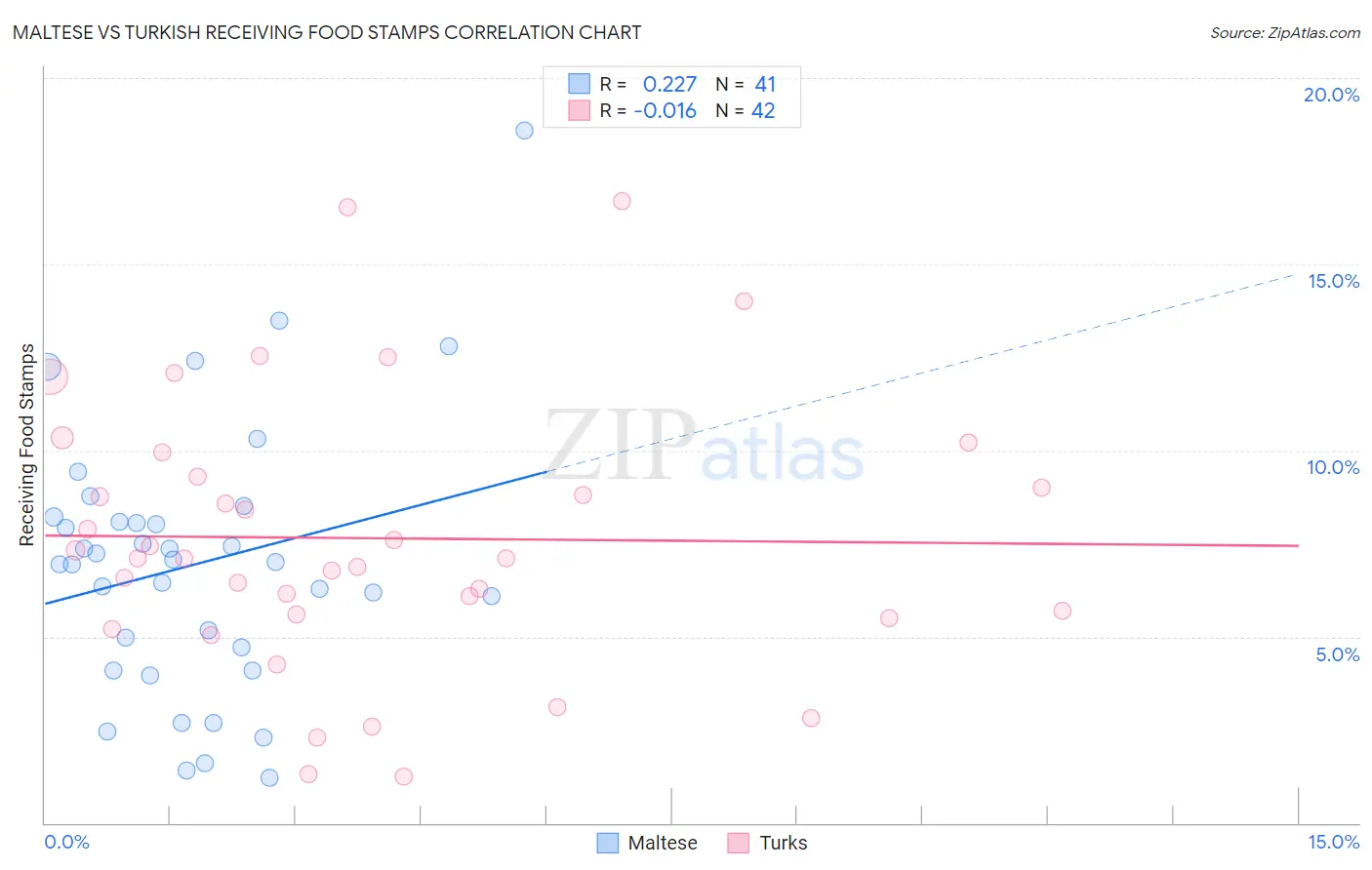Maltese vs Turkish Receiving Food Stamps
COMPARE
Maltese
Turkish
Receiving Food Stamps
Receiving Food Stamps Comparison
Maltese
Turks
8.9%
RECEIVING FOOD STAMPS
99.9/ 100
METRIC RATING
14th/ 347
METRIC RANK
9.5%
RECEIVING FOOD STAMPS
99.6/ 100
METRIC RATING
34th/ 347
METRIC RANK
Maltese vs Turkish Receiving Food Stamps Correlation Chart
The statistical analysis conducted on geographies consisting of 126,326,632 people shows a weak positive correlation between the proportion of Maltese and percentage of population receiving government assistance and/or food stamps in the United States with a correlation coefficient (R) of 0.227 and weighted average of 8.9%. Similarly, the statistical analysis conducted on geographies consisting of 271,161,413 people shows no correlation between the proportion of Turks and percentage of population receiving government assistance and/or food stamps in the United States with a correlation coefficient (R) of -0.016 and weighted average of 9.5%, a difference of 6.5%.

Receiving Food Stamps Correlation Summary
| Measurement | Maltese | Turkish |
| Minimum | 1.2% | 1.2% |
| Maximum | 18.6% | 16.7% |
| Range | 17.4% | 15.5% |
| Mean | 6.9% | 7.6% |
| Median | 7.0% | 7.1% |
| Interquartile 25% (IQ1) | 4.4% | 5.6% |
| Interquartile 75% (IQ3) | 8.2% | 9.3% |
| Interquartile Range (IQR) | 3.8% | 3.7% |
| Standard Deviation (Sample) | 3.6% | 3.6% |
| Standard Deviation (Population) | 3.5% | 3.6% |
Demographics Similar to Maltese and Turks by Receiving Food Stamps
In terms of receiving food stamps, the demographic groups most similar to Maltese are Norwegian (9.0%, a difference of 0.66%), Immigrants from Japan (9.0%, a difference of 0.93%), Immigrants from Scotland (9.0%, a difference of 1.1%), Danish (9.0%, a difference of 1.5%), and Immigrants from Hong Kong (9.1%, a difference of 2.1%). Similarly, the demographic groups most similar to Turks are Zimbabwean (9.5%, a difference of 0.010%), Bolivian (9.3%, a difference of 1.5%), Immigrants from Eastern Asia (9.3%, a difference of 1.8%), Immigrants from Sweden (9.3%, a difference of 2.2%), and Immigrants from Lithuania (9.2%, a difference of 2.6%).
| Demographics | Rating | Rank | Receiving Food Stamps |
| Maltese | 99.9 /100 | #14 | Exceptional 8.9% |
| Norwegians | 99.9 /100 | #15 | Exceptional 9.0% |
| Immigrants | Japan | 99.9 /100 | #16 | Exceptional 9.0% |
| Immigrants | Scotland | 99.9 /100 | #17 | Exceptional 9.0% |
| Danes | 99.9 /100 | #18 | Exceptional 9.0% |
| Immigrants | Hong Kong | 99.8 /100 | #19 | Exceptional 9.1% |
| Latvians | 99.8 /100 | #20 | Exceptional 9.1% |
| Luxembourgers | 99.8 /100 | #21 | Exceptional 9.1% |
| Immigrants | Australia | 99.8 /100 | #22 | Exceptional 9.2% |
| Eastern Europeans | 99.8 /100 | #23 | Exceptional 9.2% |
| Immigrants | Northern Europe | 99.8 /100 | #24 | Exceptional 9.2% |
| Immigrants | Ireland | 99.8 /100 | #25 | Exceptional 9.2% |
| Swedes | 99.8 /100 | #26 | Exceptional 9.2% |
| Bhutanese | 99.8 /100 | #27 | Exceptional 9.2% |
| Czechs | 99.8 /100 | #28 | Exceptional 9.2% |
| Immigrants | Lithuania | 99.8 /100 | #29 | Exceptional 9.2% |
| Immigrants | Sweden | 99.7 /100 | #30 | Exceptional 9.3% |
| Immigrants | Eastern Asia | 99.7 /100 | #31 | Exceptional 9.3% |
| Bolivians | 99.7 /100 | #32 | Exceptional 9.3% |
| Zimbabweans | 99.6 /100 | #33 | Exceptional 9.5% |
| Turks | 99.6 /100 | #34 | Exceptional 9.5% |